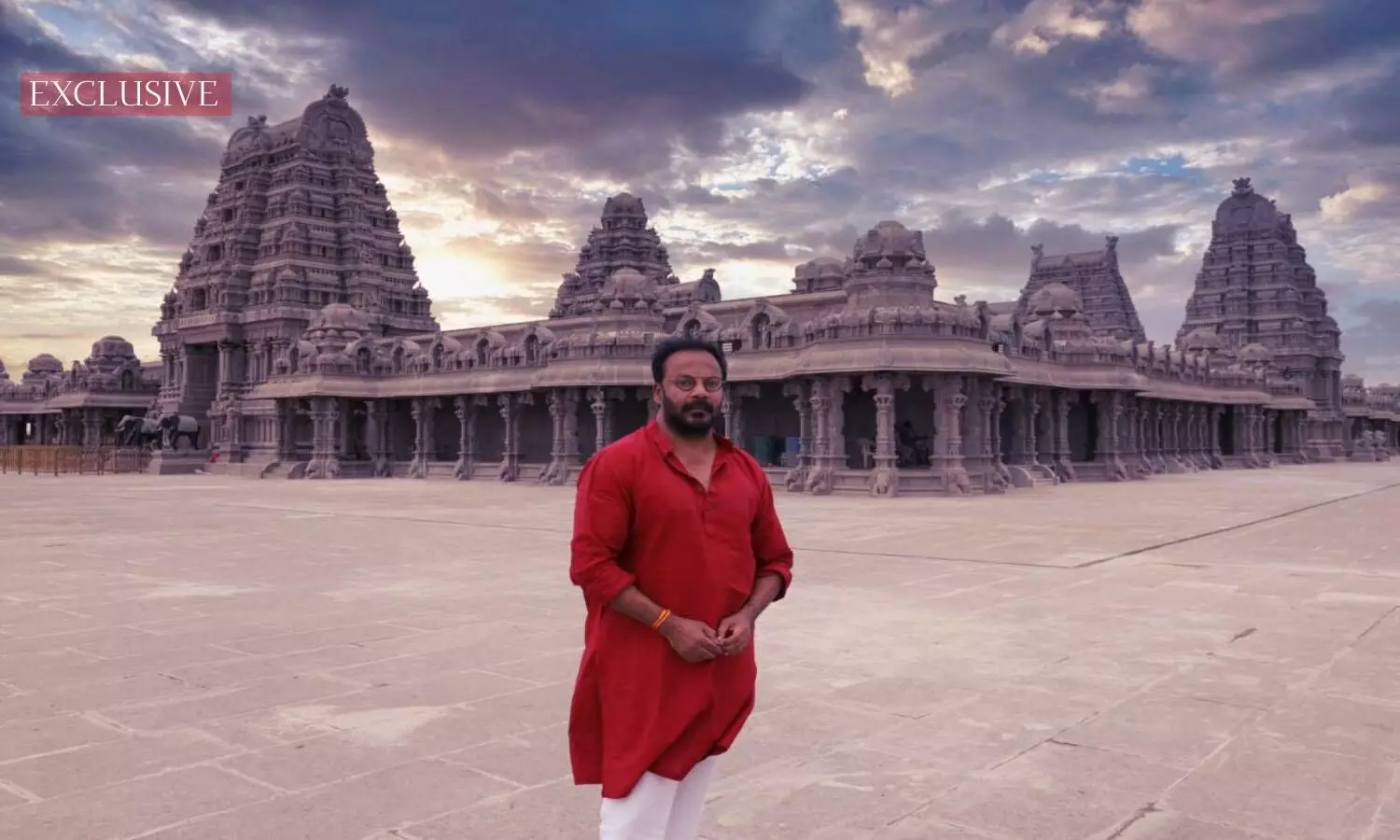Anand Sai: From film set designer to Yadagirigutta temple architect
Anand Sai is a renowned Art Director in the Telugu Film Industry. He has designed sets for various Telugu films including Yamadonga, Sainikudu, Puli, Brindavanam, Naani, Gudumba Shanker. Since 2016, he has devoted his entire time to the development of the Yadagirigutta temple.
By Amrutha Kosuru
Yadagirigutta is no longer the ancient cave shrine. It is now a 17-acre, three-storeyed temple with seven gopurams. The new temple has been built around the 1000-year-old shrine without disturbing or altering it.
Only Krishnashila rocks were used in carving the sculptures. Rocks weighing 2.5 lakh tonnes were quarried and transported to Yadigirigutta over the years.
Not an ounce of cement has been used in layers in the temple. Lime was used instead of cement. Traditional construction methods were used to build the temple.
The brain behind the architecture of the temple is Anand Sai. Chief Architect of the newly built Yadagirigutta temple, he has been working on the project for the last six years. "When I questioned why I was picked for the project, CM KCR said that he was impressed with my way of designing film sets in accordance with Vastu," Anand said in an Exclusive interview with NewsMeter. He also feels that his extensive knowledge of temple architecture is another reason he was chosen for the project.
Anand Sai is a renowned Art Director in the Telugu Film Industry. He has designed sets for various Telugu films including Yamadonga, Sainikudu, Puli, Brindavanam, Naani, Gudumba Shanker. Since 2016, he has devoted his entire time to the development of the Yadagirigutta temple.
In conversation with NewsMeter, Anand Sai said the project is like his child and now that it's nearing completion. "I have an emotional connection with this place and every rock in the temple," he said.
Anand Sai visited several temples across South India and drew inspiration from them for Yadagirigutta. "The old, actual temple hasn't been touched. The Swayambhu (the original temple grounds) and Garbhugudi (main temple) are as they are," he said. The hanuman carving and other parts of the cave temple have remained untouched. The new temple has been built around it.
Anand explained that he was inspired by Dravidian Architecture and said that many might feel like they are inside an age-old Madhurai temple. "The seven gopurams have been inspired by Srirangam Temple in Tiruchirapalli. There are four gopurams on each side and three in the middle of the temple," he said. The Rajagopuram (pyramidal structure at the entrance of the temple) is seven-storey high and made of stones weighing 13,000 tonnes.
Spacious and in accordance to Vastu and Agama Shastra, another unique feature about the temple are the queue lines. "Yadagirigutta is a very popular temple. Earlier temple's area was quite small. When the development of the temple began, the primary aim was to provide all the necessary facilities for the pilgrims," Anand explained. "We didn't just increase the area of the temple but we have designed the queue lines in such a way that they provide a divine experience to the public," he said.
People can find beautiful sculptures of various mythological gods like Hanuman, various forms of Sri Narasimha Swamy, and many more. "Some of the sculptures are short and immersive mythological stories," he said.
All the sculptors hail from various parts of Telangana, Andhra Pradesh, and a few parts of Tamil Nadu. "The work didn't stop when the pandemic hit the state," Anand said proudly.
"We arranged their stay, food for everyone and all the workers sculpted various idols, pillars, and more in the temple premises during both the waves of the Covid-19 pandemic," he said.
While the pandemic did slow down some work, the temple construction never stopped or paused.
The newly developed courtyard outside the Garbhagudi (main temple) is now home to several monkeys who have been staying on the gutta (hill) since its inception. Come noon, one can find monkeys taking their mid-noon nap on the cool Krishna Sila rocks away from the scorching sun.
The Vimana Gopuram (main Gopuram inside the temple) has been covered in gold weighing about 12 kilos and is 56 feet high. This has been inspired by the Sri Venkateshwara Swamy Temple in Tirupathi, Andhra Pradesh. The total cost of expansion of the temple amounts to Rs 1,200 crores. CM KCR wished to cover the Vimana Gopuram with gold and has sought out donations from various devotees for the same.
Another striking feature in the temple is its lighting. "Thousands of bulbs have been installed around the temple. After sunset, the whole temple will be lit and it will ensure that the temple will be visible from as far as 3-4 km away," Anand Sai explained.
Anand Sai says that building the temple would not have been possible without the help of authorities and hundreds of other people who have worked on the project. "CM KCR supported me with all the necessary resources. He would frequently talk to me regarding temple works and suggest some designs. He kept motivating me throughout," he said.
"I found the temple to be different every time I saw it. Every time, the temple's beauty was different. I hope the public likes it too," he said.
The transition from working on movies to working on the temple was not easy for Anand Sai. And he has been working on the Yadagirigutta Temple for over seven years now. Over time, he got several offers to work in movies again but he didn't. While he is not sure when or whether he will return to the Telugu Film Industry, he is confident that he will continue to pursue temple architecture. "This is my heart," he said.